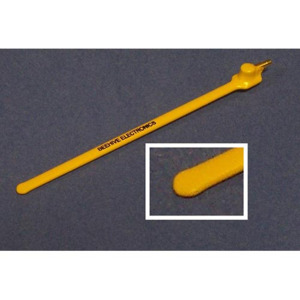
Condition:New
- Description
- Specifications
- Documents
- Multiple loop sizes offer optimum sensitivity and spatial resolution at different frequencies.
- Probe dimensions optimized for access to tight spaces.
- An integrated electrostatic shield in the loop probes eliminates common-mode pickup.
- Calibrated sensitivity up to 3 GHz, depending on model. Usable to beyond 6 GHz.
- Can be driven by a signal source to generate fields for electromagnetic susceptibility testing.
The 100B magnetic field probe has the smallest loop of any probe in the series. It offers the best spatial resolution and high-frequency response of the magnetic field probes, but has lower sensitivity than the 100A or 100C.
The 100 series EMC probes are designed for identifying and fixing EMC problems. The 100A, 100B, and 100C are loop probes, and are sensitive to magnetic fields. The 100D is a stub probe, and is sensitive to electric fields.
The loop probes have integrated electrostatic shields, providing isolation from common mode signals. As a result, these probes deliver excellent repeatability. The different loop sizes allow the user to select the optimum probe for a given frequency, providing the optimum sensitivity and spatial resolution.
The 100D stub probe, with its narrow tip, offers the highest spatial resolution. It is ideally suited to tasks such as tracking EMC sources down to the individual pins of an IC.
Because of the planar construction of the probes, even the large loops are only 0.11" thick, allowing the probe to be inserted into narrow seams and gaps.
